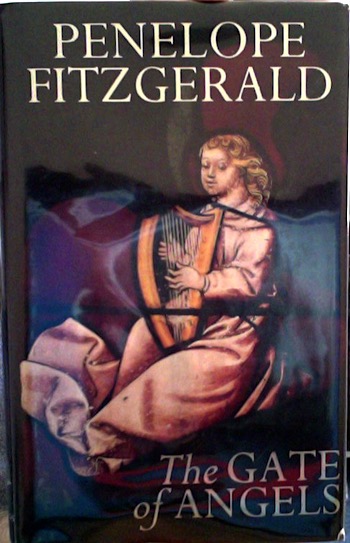Inspiring Older Readers
 posted on 30 May 2022
posted on 30 May 2022
The Gate of Angels by Penelope Fitzgerald
The novelist and biographer, Penelope Fitzgerald, who died in 2000, had a remarkable career. She was born in 1916 into the upper class Knox family. Her father, Edmund, was editor of Punch; her uncle, Ronald, was a writer, broadcaster, theologian, and chaplain of Trinity College, Oxford. Her mother, Christina Hicks, was the daughter of the Bishop of Lincoln.
Fitzgerald’s first works, all written when she was in her fifties, were rather rarified biographies (of Edward Burne-Jones; the Knox brothers; and the Victorian poet Charlotte Mew). But then, at the age of 62, she published her first novel, The Bookshop, following this with three more elegant, quiet, small-scale, avowedly English novels, all largely autobiographical in tone. The second of these, Offshore, won the Booker Prize in 1979. But it was a controversial decision and aside from this brief acclaim the widely held view was that her novels were rather too quiet, too English and too undemonstrative. As the booktrade was dragged kicking and screaming into the financial Big Bang 1980s, bigger, brasher, newer, younger and more transgressive novelists were the order of the day.
And then in 1986, and apparently effortlessly, beginning with Innocence, Fitzgerald adopted a bigger canvas and published a series of four historical novels with settings as varied as 1950s Florence, eighteenth century Germany, and pre-revolutionary Russia.
The Gate of Angels (1990) is one of these remarkable, late historical novels and is set in the distinctly male, privileged, upper middle class world of Cambridge colleges in 1912. Old certainties – in science, maths, physics, philosophy; and between the genders and social classes – are being challenged. At the heart of the story is a love affair between a young physicist, Fred Fairly, in his mid-twenties, a Junior Fellow of St Angelicus College, and working class Daisy Saunders, just twenty, and a trainee nurse. One dark night Fred and Daisy collide on their bicycles, the accident caused by a casual labourer who is driving a farmer’s wagon, perhaps drunkenly, perhaps asleep. It is significant that here and elsewhere in the book, events are instigated in ‘collisions’ between upper middle class academia and working class protagonists. Although handled in the lightest of ways – typical of Fitzgerald – class antagonism is a major part of the novel.
Edwardian Cambridge is beautifully atmospheric – its bitter cold, its gas-lit streets, its antiquated attitudes and habits, its ancient buildings and pitch-black secluded quadrangles. But the novel also illustrates Fitzgerald’s sleight of hand and craftiness: nothing is quite what it seems and overall the book never seems to have quite the shape or trajectory that I remember it having. This I am sure is intentional and central to the story. We seem to falter towards a fuller understanding of the circumstances in which Fred and Daisy meet while at the same time being gradually introduced to the controversies of the day – the exclusion of women from the universities, the mounting political pressures for women’s political rights, the new revolutionary ideas (and uncertainties) in physics. At times it seems as if virtually everyone in the novel is questioning what they do, uncertain of their motives, their intentions, their desired outcomes. Uncertainty seems to permeate the very air, much as fenland damp permeates the buildings.
While I love all of Fitzgerald’s novels, and especially the earlier, more autobiographical ones, I sometimes feel that The Gate of Angels seems not to have quite the sureness or lightness of touch that so characterise the rest of her work. For instance, I’m not sure that her forte was really the depiction of working class characters and I don’t find Daisy Saunders quite convincing. The official attempts to get to the bottom of a minor traffic collision – a couple of cyclists, a farm cart – seem both overdone and unlikely. The gradual revealing of the real reason for Daisy’s presence in Cambridge on the night of the bicycle accident also seems a bit laboured. And perhaps most surprisingly, the depiction of Dr Matthews, the Provost of James’s, a thoroughly M. R. Jamesian character, seems to need a touch more finesse.
Each time I reread The Gate of Angels I find myself wondering anew whether these are faults of the book or faults in my reading. I never quite reach a conclusion. I don’t think this is amongst Fitzgerald’s finest novels but I balance this against its superlative descriptive writing and evocation of atmosphere and the fact that each time I read it new depths and new pleasures are revealed – including a lovely, sly humour which is not immediately evident but once tuned into enlivens almost every page. And I don’t think I am imagining that there is also a mysteriously conveyed undercurrent of tragic melancholy – almost entirely unspoken – as the conflagration of the Great War approaches.
Alun Severn
May 2022
Penelope Fitzgerald elsewhere on Letterpress:
The Bookshop by Penelope Fitzgerald